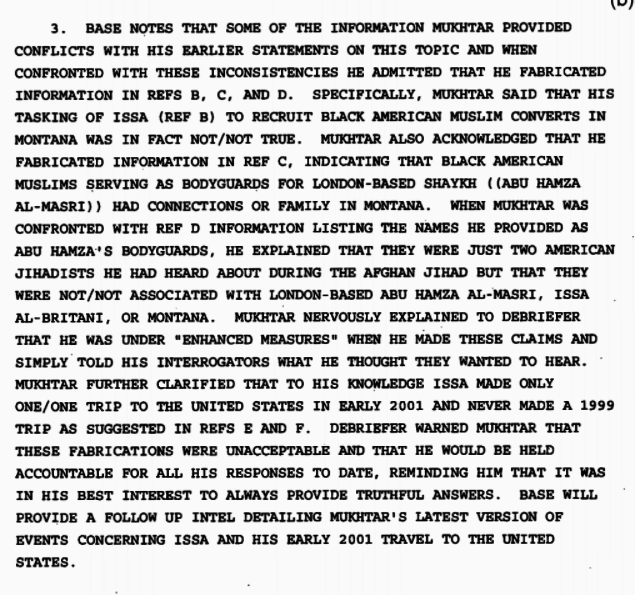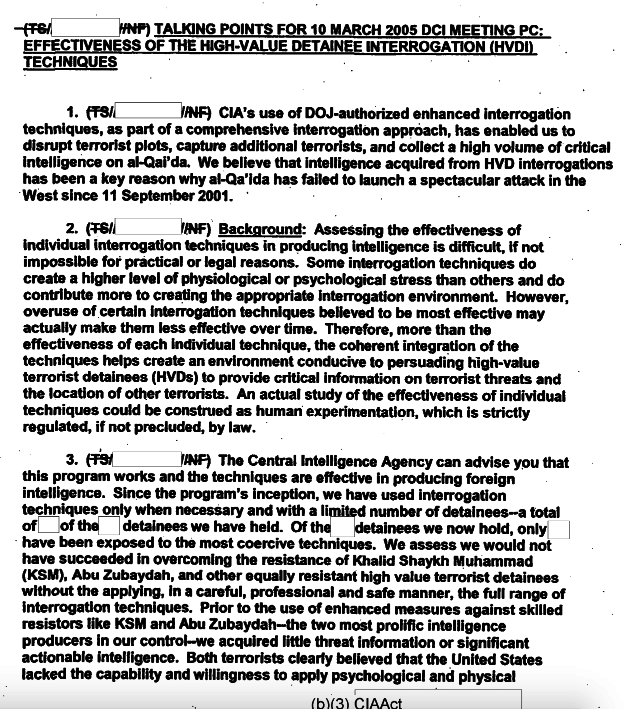
As Gina Haspel, President Donald Trump’s pick to lead the CIA, faces a Senate grilling about her role in the agency’s post-9/11 torture program, nearly 300 pages of newly declassified CIA documents give an unprecedented look at the chaotic early days of the agency’s so-called rendition, detention, and interrogation program — including a time when Haspel helped oversee it.
The alleged mastermind of the 9/11 attacks lied and fabricated information to avoid torture, the documents show. Another detainee provided key information before being subjected to the some of the harshest torture techniques, such as waterboarding — and interrogators kept torturing him even after they determined he very likely had no more new threat information to give.
The CIA documents released to BuzzFeed News are heavily redacted and do not mention Haspel by name, but they largely cover the years immediately following the Sept. 11 attacks, some of which Haspel spent working at the CIA’s Counterterrorism Center, which oversaw the torture program. According to the CIA, Haspel was a deputy group chief at the CTC from 2001 to 2003 and was a senior-level supervisor at the CTC from 2003 to 2004.
The documents pertain heavily to the torturous treatment in 2003 of alleged 9/11 mastermind Khalid Sheikh Mohammed, as well as Abu Zubaydah, the CIA’s first high-value captive who was held at a black site prison in Thailand in 2002. Haspel briefly ran the black site a couple of months after Abu Zubaydah's torture ended. She took over the management of the prison in October 2002, shortly before another detainee, Abd al-Rahim al-Nashiri, the alleged mastermind of the USS Cole bombing, was rendered there and tortured. According to a person familiar with what Haspel has told senators in private meetings, “it was not until October 2002 that she was briefed on some of the agency's more sensitive counterterrorism authorities and activities. Contrary to some descriptions in the press, she did not devise these activities nor advocate for their approval.”
Abu Zubaydah's and al-Nashiri’s torture sessions were videotaped at least a dozen times between April 2002 and December 2002, and Haspel, a veteran counterterrorism officer, was an advocate for destroying those videotapes and drafted the cable authorizing their destruction. An internal CIA review of the incident cleared her of wrongdoing.
The documents, which include cables, detailed narratives about several detainees’ torture, PowerPoint presentations, talking points, and legal analyses, were obtained by BuzzFeed News and Ryan Shapiro, a PhD candidate at MIT and the cofounder of the transparency project Property of the People, in response to a long-running Freedom of Information Act lawsuit.
Despite what critics call the selective declassification of information about Haspel’s career, much of it has remained a secret. Several Democratic senators on the Intelligence Committee, which will host Haspel’s confirmation hearing on Wednesday, have urged the CIA to declassify information about Haspel’s role in the “deeply flawed” program, “as well as a number of other disturbing facts about her record.” Like all members of the committee, the three senators — Dianne Feinstein, Ron Wyden, and Martin Heinrich — have access to classified materials, more of which the CIA delivered to Capitol Hill on Monday.
With at least one Republican, Kentucky Sen. Rand Paul, opposing her nomination and Arizona Republican Sen. John McCain absent while fighting brain cancer, Haspel will require at least some Democratic support to be confirmed. On Friday, she sought to withdraw her nomination after the White House raised questions about her role in the torture program, the Washington Post reported.
My highly respected nominee for CIA Director, Gina Haspel, has come under fire because she was too tough on Terrorists. Think of that, in these very dangerous times, we have the most qualified person, a woman, who Democrats want OUT because she is too tough on terror. Win Gina!
Though many Republicans on the Intelligence Committee say they are satisfied with what they know about Haspel’s role in the torture program, GOP Sen. Susan Collins says she wants to know more. “I still will want to ask her a series of questions about what she knew about the brutal treatment of some of the detainees and so I’m sure she’s going to have a lot of questions in that area,” Collins, who has met with Haspel, told BuzzFeed News last week. “But I’ll also ask her questions about where she sees the appropriate role for the CIA and just more general questions as well.”
Asked Monday if she wants to question Haspel about the program's efficacy, Collins said: “I’m sure that that’ll be one of many issues that will be raised at her hearing.”
Daniel Jones, the lead author of the Senate Intelligence Committee’s 6,700-page torture report, declined last week to quantify how much Haspel figures within the full, classified report, but told reporters the torture program was “horribly mismanaged” and that, given her work in the counterterrorism center at the time, Haspel “would have been aware of the deficiencies in the program.”
The documents obtained by BuzzFeed News are cited as the footnotes to the committee’s publicly released, 500-page executive summary of the report. One heavily redacted document — “legal considerations for CIA officers” — reveals that two months after 9/11, the CIA was exploring whether the US government should adopt a policy of torture. “A policy decision must be made with regard to U.S. use of torture in light of our obligations under international law, with consideration given to the circumstances and to international opinion on our current campaign against terrorism-states may be very unwilling to call the U.S. to task for torture when it resulted in saving thousands of lives,” states a bullet point in the document, marked TOP SECRET.
Documents from the spring of 2003 reveal that Khalid Sheikh Mohammed — or “Mukhtar,” as he was also known — fabricated information about several threats and individuals while being tortured. “Mukhtar nervously explained to debriefer that he was under ‘enhanced measures’ when he made these claims and simply told his interrogators what he thought they wanted to hear,” reads a document dated June 2003.

Though the documents say he did provide information to interrogators about plots in the United Kingdom, Pakistan, and the US, Khalid Sheikh Mohammed’s omissions and fabrications had created long-standing concerns at CIA headquarters. “KSM’s pattern of behavior over the past three months, trying to control his environment, lying and then admitting things only when pressed that others have been caught and have likely admitted the plot, is a cause for concern,” states another June document, which includes a detailed list of the issues with his behavior, ranging from complaints about stolen cheese to disobeying guards.
“We think that it is entirely possible that he may never provide information on additional plots, but we believe that we would be remiss if we did not look at the possibility of changing his environment to gain further cooperation,” the cable reads.
The CIA and supporters of the torture program have maintained that suspects such as Khalid Sheikh Mohammed and Abu Zubaydah provided key information about terror plots after undergoing the harshest interrogation techniques, in Abu Zubaydah’s case, the documents appear to show that he provided significant information before being waterboarded.
One document, dated April 2002 — months before the CIA would begin “enhanced” interrogations — notes that Abu Zubaydah “provided information on a potential terrorist plan involving the use of an explosive device containing uranium” involving two men known as the “Kenyan” and the “American.”
Abu Zubaydah still proved resistant, however, prompting the CIA to change their interrogation strategy to an aggressive one that spring. On May 19, 2002, Abu Zubaydah’s “beliefs and assumptions were severely dislocated by the mysterious and angry man who stripped him of his clothes and expectations,” reads a June document assessing the evolution of his cooperation.
The team had hooded and handcuffed Abu Zubaydah, the document says. “A member of the interrogation team (one of the psychologists) — whose voice subject had never heard before — entered the cell in a brusque manner, violently tossed the plastic patio chair against the cell wall, and abruptly ripped off subject’s clothes. After doing this, the team member asked the subject, ‘Are you sure that you want to go down this path...later on, remember it was you who chose it?’ Subject was clearly taken aback and visibly shaken by the wholly unexpected and disconcerting action.”
The document says the team then played “loud abrasive music” and left Abu Zubaydah “sitting on the floor naked for an hour to ponder and reconsider his situation.” He then “appeared to accept a face-saving way to provide threat information and then immediately began talking about possible threats that he had not discussed in such detail before.” He later gave them notes that “included threat and operational information.”
“In addition to providing the notes, subject began to speak rapidly and deliver an outpouring of information,” the document says.
On June 18, Abu Zubaydah was read a scripted message, then subjected to a similar “crisis precipitation” event during which he was handcuffed, hooded, and left naked in his cell; “essentially telling the subject that no one would tolerate being jerked around by him anymore when they ask for information.” The CIA document says interrogators then gave Abu Zubaydah another opportunity to provide threat information, with him responding: “What I have, I give it all...I have no more.”
The documents illustrate how later, in August of that same year, Abu Zubaydah would undergo days of waterboarding and fail to provide new threat information. “At this juncture in the aggressive interrogation process, it is the team’s collective preliminary assessment that it is highly unlikely subject has any actionable new information about current threats to the United States,” reads a cable dated August 2002. “That said, the team plans to maintain the current level of psychological pressures for the time being to develop and refine this preliminary assessment.”
The CIA has so far not offered any insight into whether Haspel believes the torture program was an effective means of gleaning intelligence from detainees and staving off attacks in the aftermath of the Sept. 11. She has, however, privately told senators that she would not restart the program despite the fact that Trump has vowed to bring back waterboarding and other torture methods.
“Her and I have had some really good conversations,” West Virginia Sen. Joe Manchin — a red-state Democrat whose vote could sway Haspel’s confirmation — told BuzzFeed News, “and I’m very interested in when she comes before the committee and we’re able to ask her directly, and she says directly her involvement, her role that she played. […] I think she has to clear that — she cleared it up with me, I want to hear it in committee.”
The documents make clear that the CIA does not believe the effectiveness of the techniques themselves can be evaluated though. “Assessing the effectiveness of individual interrogation techniques in producing intelligence is difficult, if not impossible for practical or legal reasons,” reads a document dated March 2005. According to the document, which lists talking points for an upcoming meeting with the CIA director, “more than the effectiveness of each individual technique, the coherent integration of the techniques helps create an environment conducive to persuading high-value terrorist detainees (HVDs) to provide critical information on terrorist threats and the location of other terrorists.”

“The Central Intelligence Agency can advise you that this program works and the techniques are effective in producing foreign intelligence,” the document adds, arguing that the CIA “would not have succeeded in overcoming the resistance of Khalid Shaykh Muhammad (KSM), Abu Zubaydah, and other equally resistant high value terrorist detainees without the applying, in a careful, professional and safe manner, the full range of interrogation techniques.”
Former top CIA lawyer John Rizzo, in his book Company Man, might shed some light on how Haspel felt about the program’s effectiveness though. “[L]et me offer a somewhat different perspective on why I became convinced during those first couple years of the program that it was the necessary and right thing to do,” Rizzo wrote in 2014. “It comes down to something pretty basic: Every, and I mean every, career CIA employee who was involved in it believed in it wholeheartedly and unswervingly.”
You can read the documents here.


